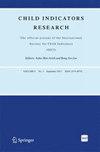How do Children Rate Their Health? An Investigation of Considered Health Dimensions, Health Factors, and Assessment Strategies
IF 2
3区 社会学
Q1 SOCIAL SCIENCES, INTERDISCIPLINARY
引用次数: 0
Abstract
Abstract In large-scale surveys of both children and adults, self-rated health (SRH) based on questions such as “In general, how would you rate your health?” is a widely used measurement to assess individuals’ health status. However, while a large number of studies have investigated the health aspects people consider for their responses, and some studies show deeper insights into the assessment strategies in answering this question for adults, it is largely unknown how children assess their health based on those questions. Therefore, this study examines how children rate their health according to this question in a sample of 54 9- to 12-year-olds. By using techniques of cognitive interviewing and qualitative and quantitative content analysis, we investigate the health dimensions, health factors as well as different assessment strategies that children refer to in their self-assessment of general health. Our results indicate that children in this age group mostly refer to their physical health and daily functioning or consider health more non-specifically. They also show that children take into account a wide range of specific health aspects, with some minor differences between subgroups, especially by gender. Additionally, our study highlights that children use several assessment strategies. Finally, our results indicate that the majority of children assess their health only using one health dimension, but a substantial share of children reflect on several health factors and combine different assessment strategies. We conclude that children refer to comparable health dimensions and health factors, but use somewhat different assessment strategies compared with studies focusing on adults.

儿童如何评价自己的健康状况?考虑的健康维度、健康因素和评估策略的调查
在对儿童和成人的大规模调查中,自我评估健康(SRH)基于诸如“一般来说,你如何评价你的健康?”是一种广泛用于评估个人健康状况的测量方法。然而,尽管大量的研究已经调查了人们在回答这个问题时考虑的健康方面,并且一些研究显示了对成人回答这个问题的评估策略的更深入的见解,但儿童如何根据这些问题评估自己的健康在很大程度上是未知的。因此,这项研究调查了54名9至12岁的儿童如何根据这个问题评估他们的健康状况。本研究采用认知访谈和定性与定量内容分析相结合的方法,对儿童一般健康自我评价的健康维度、健康因素以及不同的评估策略进行了研究。我们的研究结果表明,这个年龄组的儿童主要是指他们的身体健康和日常功能,或者更多地考虑健康。这些数据还表明,儿童考虑到广泛的具体健康方面,各小群体之间存在一些细微差异,特别是按性别区分。此外,我们的研究强调儿童使用几种评估策略。最后,我们的结果表明,大多数儿童只使用一个健康维度来评估自己的健康,但相当一部分儿童反映了几个健康因素,并结合了不同的评估策略。我们的结论是,儿童指的是可比较的健康维度和健康因素,但与针对成人的研究相比,使用的评估策略有所不同。
本文章由计算机程序翻译,如有差异,请以英文原文为准。
求助全文
约1分钟内获得全文
求助全文
来源期刊

Child Indicators Research
SOCIAL SCIENCES, INTERDISCIPLINARY-
CiteScore
4.90
自引率
14.30%
发文量
103
期刊介绍:
Child Indicators Research is an international, peer-reviewed quarterly that focuses on measurements and indicators of children''s well-being, and their usage within multiple domains and in diverse cultures. The Journal will present measures and data resources, analysis of the data, exploration of theoretical issues, and information about the status of children, as well as the implementation of this information in policy and practice. It explores how child indicators can be used to improve the development and well-being of children. Child Indicators Research will provide a unique, applied perspective, by presenting a variety of analytical models, different perspectives, and a range of social policy regimes. The Journal will break through the current ‘isolation’ of academicians, researchers and practitioners and serve as a ‘natural habitat’ for anyone interested in child indicators. Unique and exclusive, the Journal will be a source of high quality, policy impact and rigorous scientific papers. Readership: academicians, researchers, government officials, data collectors, providers of funding, practitioners, and journalists who have an interest in children’s well-being issues.
 求助内容:
求助内容: 应助结果提醒方式:
应助结果提醒方式:


